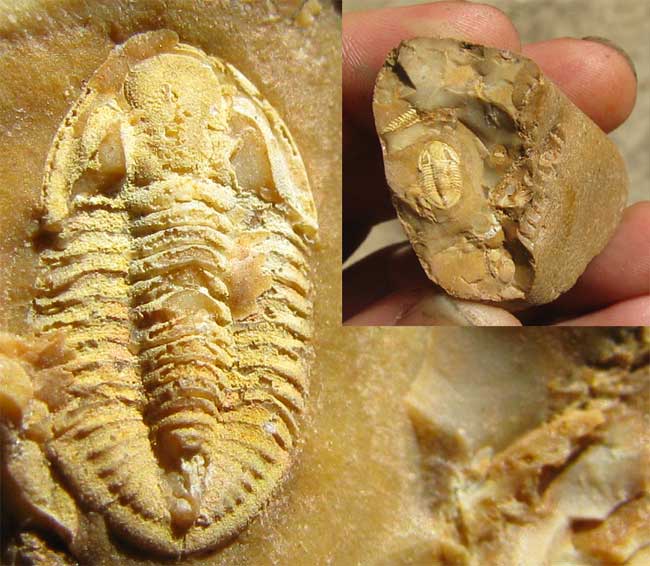Excerpts from Jim Conrad's
Naturalist Newsletter

from the August 4, 2008 Newsletter, issued from the forest near Natchez, Mississippi; elevation ~400ft (120m), ~N31.47°, ~W91.29°:
A CERAURUS TRILOBITE
Above you can see one of Karen's prized fossils. It's a tiny trilobite found inside a cracked-open chert pebble found in a gravel pit near Natchez. Trilobites are extinct arthropods that lived from Early Cambrian, about 540 millions years ago, until going extinct at the end of the Permian, about 250 million years ago. During much of the history of Life on Earth trilobites were among the most numerous and diverse forms of life, with some 17,000 known species spanning Paleozoic time.
Since the topmost gravel around Natchez was deposited during the Pleistocene only about 700,000 years ago, or 0.7 million years, Karen's trilobite, which couldn't have been fossilized less than 250 million years old, wasn't fossilized in place here. The pebble carrying the trilobite inside was transported to here as part of an enormous amount of gravel deposited here by meltwater from the retreating glacier in the north.
To get a name for Karen's trilobite I went to the nifty Fossil Forum at http://www.thefossilforum.com. This public forum for fossil fanciers includes a section on "Fossil ID." I registered for free, uploaded the picture linked to above, and before the day was over two experts had told me what they thought.
Solius in the central US wrote, "The pygidium looks like it could be a proetid, but it appears to have glabellar, and occipital lobes like a Ceraurus... It is a nice one, and probably fairly rare."
The genus Ceraurus occurred mostly during the Orodovician age (±488.3 to ±443.7 mya) and is most commonly found in strata outcropping in the lower Great Lakes region. That fact meshes nicely with what's said on my "Gravel Below the Loess" page at https://www.backyardnature.net/loess/citronel.htm:
... the topmost gravel [around Natchez] is of Ice- Age, or Pleistocene, age, in the general neighborhood of 700,000 years old. Earl Manning at Tulane makes the interesting comment that 'The reason that you can find agates in [the gravel] at Natchez, is that it's been washed south from the Lake Superior area (where the agates originally came from) by the Mississippi River.
Beautiful how it all comes together...